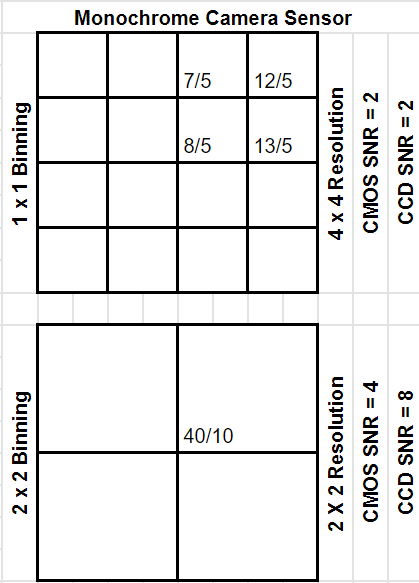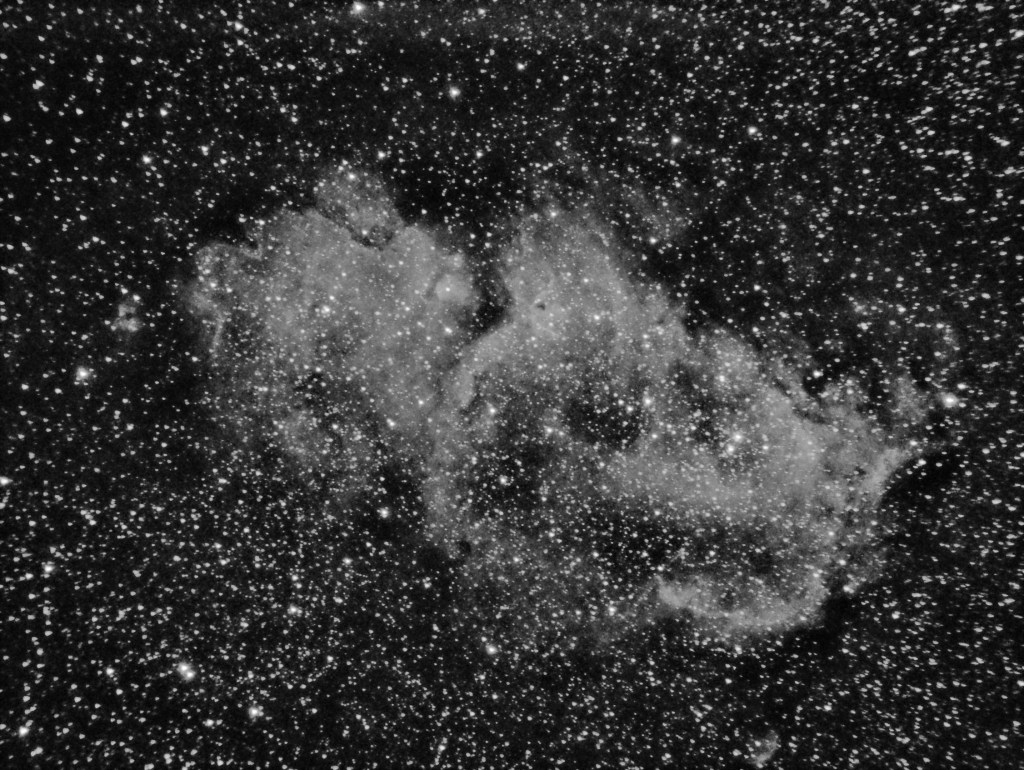Comparatively, anyone starting out can find binning in astrophotography mysterious. What does it mean to combine pixels? Why would I want to combine pixels? All in all great questions and I’m sure you have more. Of course I’m going to pull back the curtain. Specifically because I’ve ventured into the dedicated astronomy camera space. Now buckle up. Let’s go.
So before we get too deep into the depths of binning, consider taking a moment to gather information about your camera sensor. In the event that your DSLR manufacturer website does not have the information, you can use https://www.digicamdb.com/. Additionally, ZWO, ATIK, QHY, etc. do a great job of maintaining their camera info.
What is Binning In Astrophotography?
Understanding signal to noise ratio or SNR is required in order to understand binning. In simplest terms, signal comes from the photons you want to collect and noise comes from everything else. To clarify, stacking will reduce noise, so binning is not a replacement for stacking.
SNR Example
In order to illustrate signal to noise, take a look at the photo below. The top has high noise therefore a low SNR. In addition the bottom has low noise resulting in a high SNR.


As explained, binning will not replace stacking, but does help to improve SNR. So what really is binning?
How Camera’s Bin
Cameras bin by combining the pixels next to it into one larger pixel. As a result the photo loses resolution. To demonstrate, a camera sensor with 4096 pixel length and a 4096 pixel width has approximately 17 Megapixel resolution. Therefore after applying a 2 x 2 bin, that resolution becomes 2048 x 2048 or 4 Megapixels. Let’s consider both the CCD and CMOS sensors in monochrome cameras.
Binning Combinations
When considering both sensor types an image where binning is listed as 1 x 1 maintains it’s full resolution. Whereas, 2 x 2 binning reduces the pixel quantity by 2. A 3 x 3 binning reduces by 3 and so on. To illustrate this, here’s a 2 x 2 example.


How CCD & CMOS Sensor Work
In order to explain the real power of binning, I’ve got to get a bit more technical. Our objective as astrophotographers is to capture photons from a light source or reflective light source. In other words, we’re capturing the signal on the photosensitive sensor. As a result a photon striking the sensor surface an electron is excited to a voltage that can be measured.

In short, the energy level contained in the photon is reflected in the energy level of the electron voltage. In other words, the brighter the photon, the higher the electron voltage. The camera reads and sums the values as they are collecting on the sensor.
Camera Read Noise
In physics or statistics, there is uncertainty in determining the true value of an electron. Read noise is, consequently, the value of this uncertainty in your camera. Mathematically that uncertainty is equated to standard deviation, meanwhile in astrophotography it’s called read noise. Got it, right? No, need a little more. Ok.
We’re capturing a target with a signal of 10 eV (electron volts) and the camera has a read noise of 5 eV. It looks a little like this:

So we know the camera will read each pixel and report the analog signal. During the read, the cameras sees the pixels are reading 7, 12, 8, and 13. Accordingly, add them, divide by 4 and the signal is 10 eV. In the case of the read noise, it’s 5 for each pixel and it doesn’t sum up. Finally take that 10 divide by 5 and the SNR is 2. More clear? Good.
What Does Binning In Astrophotography Gain Me?

CMOS Sensors
Now let’s perform the binning calculations for signal to noise ratio (SNR) between both CMOS and CCD cameras. My nomenclature above is Signal/Noise in the blocks. With that understanding, you can see the signal is quadrupled during a 2 x 2 bin. Despite this result the noise is only double. Why? Again the noise is equivalent to standard deviation in statistics. In contrast, this is mathematically calculated as the square root of the sum of squares. Whew, that’s a mouthful. In the end, here’s the calculation:
√(52+52+52+52) = √(25*4) = √100 = 10
This shows the value of binning when you take that 40 and divide by 10 the SNR is 4. In conclusion it doubles the SNR of your images.
CCD Sensors
As stated previously, the camera will read each pixel individually. And this is where we find one of the significant differences between CMOS and CCD sensors. While the CMOS camera performs all of that math shown above, the CCD treats the super pixel as one and consumes the read noise value one time. As shown in the example above, the signal quadruples while the read noise remains a 5. Simplifying the math to 40 divided by 5 resulting in a SNR or 8. Wow! What we are seeing here is that binning has a far greater affect when using the CCD camera verses the CMOS.
The Color Sacrifice of Binning in Astrophotography

So you’ve spent hours collecting binned data with your color camera and you spend more time post processing it only to find out there’s no color in the image. No matter what you try, the color information is gone.
Regardless, this is true for most one shot color cameras. Now, I currently do not own a color camera that can maintain the color information, but they do exist. In addition, how they maintain color is complicated and can possibly apply the incorrect color to a pixel. Therefore remember that if you’re going to purchase a color dedicated astronomy camera, you’ll most likely only bin in post processing.
Uses for Binning In Astrophotography
In my experience, binning is best used on post processing simply because keeping resolution is important. Certainly, StarTools, Gimp, Photoshop, APP, PIxinsight, etc. can perform binning perfectly.
When scaling an image in any of these for example, the software uses what is called Bicubic Resampling. Bicubic resampling simply takes the average of the surrounding pixels based on the amount of reduction chosen. Other resampling options like bilinear and nearest neighbor are less accurate and therefore produce lower quality results.
In addition, Binning has a few other positives. One being the reduced file size. As a result, on camera binning can speed up data transfer if you’re using Wifi telescope control. Here are a few additional benefits.
Framing & Plate Solving
To clarify, the higher signal to noise ratio is perfect for framing your target. Especially where your target has dim outer details. Furthermore, it has the affect of reducing plate solving time. So if you’re like me and you plate solve to find and frame the target, this time savings is great to have.
Narrowband Imaging
Overall, the best way to save money for narrowband imaging is to skip purchasing the one shot color camera and go monochrome. Then you do not need to purchase another camera. On the other hand, what if you already have a one shot color camera? Then binning is a way to save you the added expense of purchasing another more expensive monochrome camera. Thus you would only have to purchase filters and holder/wheel. Therefore, combining that with binning, which ignores the color information, you can get into narrowband astrophotography. Either as an interim step or other.
What must be remembered, is that narrowband filters, block light. This reduces the signal to noise ratio, therefore making binning at the camera a great partner. One shot color cameras exist for a reason, which means there’s a need for them. So as those users grow and change their trajectory, this can be a great option for them. To clarify, review your own situation and make the choice best for you.
Binning in Astrophotography Conclusion
Finally, as you grow in this hobby or are simply new to binning, the more you know the greater the opportunity for you to determine the best use of binning for you. Of course the many benefits discussed are only benefits if they improve the results of your photography or add efficiency. These options can also be used to save money if you’ve already purchased a one shot color camera. Similarly, with narrowband imaging, it will improve your signal to noise ratio. Finally as you get deeper and deeper into this hobby, SNR may become even more important to you and you would then be faced with the decision between CCD or CMOS.
Thank you for reading this post on binning in astrophotography and remember that the sky is only the limit when your mind is unwilling to fly. Go beyond!


![You are currently viewing Binning In Astrophotography [To Bin or Not To Bin?]](https://i0.wp.com/kevinrfrancis.com/wp-content/uploads/2020/11/IC1848_st.jpg?fit=2253%2C1694&ssl=1)
![Read more about the article Wide Field Astrophotography and First Light with My Orion ST-80 [Andromeda Galaxy]](https://i0.wp.com/kevinrfrancis.com/wp-content/uploads/2019/09/M31_Andromeda-Galaxy_9_20_19_web.jpg?fit=300%2C231&ssl=1)
![Read more about the article How to Star Hop [Beginner Astrophotography]](https://i0.wp.com/kevinrfrancis.com/wp-content/uploads/2019/12/qtq80-S9PstL.jpeg?fit=300%2C182&ssl=1)
He Kevin.
I found your website thru FB. I am an astrophotographer too
Regards
Kevin Francis Hanley
kevin.hanley.747 on facebook.
I just retired last year 2019 in December. I was an electrical engineer.